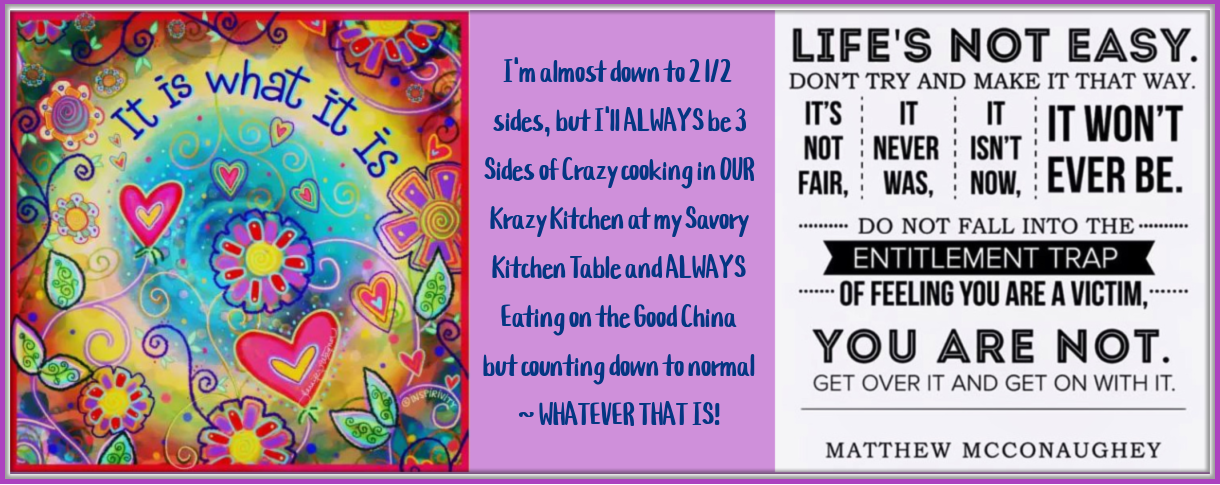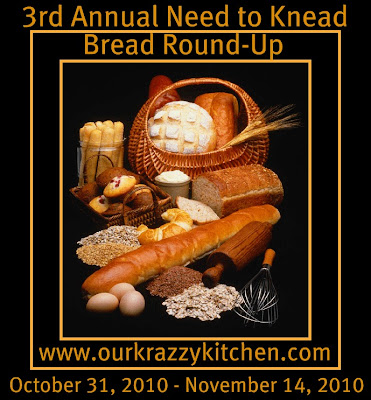We all have some favorite family bread recipes tucked away.
Just post your recipes anytime until November 15, 2010, go over and link up at OUR KRAZY KITCHEN so that we can all visit you. You can even link to recipes you have previously posted. Add this button to your participating posts and link to this blog. Your blog can be in any language, but a translator on your site will help any who don’t speak the same language.
Bread History According to National Bread Month:
Resource LinkCelebrate National Bread Month with crusty water rolls: recipe

- Recipe Curio has a lot of wonderful tips as well as many vintage recipes
- Yeast Dough gets down to the basics of the ingredients and how to work with them.
- Bread World is Fleischmann’s Yeast site for recipes and baking tips.
- Bread Baking 101 is all encompassing site of information and recipes.
- The Ultimate Guide to Sourdough is a FANTASTIC resource for all thing sourdough!
- Baking in a high place, a dry place or in a place that can have sudden changes in barometric pressure. All these factors can alter how yeast breads knead, rise and bake.
- To determine if your yeast is still active, dissolve 1 tsp. sugar in 1/2 cup lukewarm water in a see-through measuring cup. Sprinkle 1 tbsp. yeast slowly over the water. Stir and let stand for 10 minutes. At the end of this time, the yeast should have foamed up to reach the 1 cup mark. Yeast that does not reach this mark in 10 minutes will not produce a good loaf and should be discarded.
- Water can replace milk. The texture will change a little, but the bread will still be very tasty and good to eat.
- White sugar, brown sugar, honey and molasses can be interchanged equally in bread dough. The sugar in bread dough supplies the tiny yeast plants with instant food and gets them off to a fast start. Artificial sweeteners are not recommended for yeast breads because they cannot be used by the yeast as natural sweeteners can.
- Fats can be replaced with applesauce or prune puree. The texture of the bread will be more dense. A general rule of thumb is to substitute 1 1/2 tablespoons of applesauce/prune puree for every 3 tablespoons of fat.
- Salt is added to yeast breads not only for flavor but also to keep the yeast fermentation in the bread dough under control. Too little salt will allow the yeast to push the dough so high that it may even collapse. Too much salt will keep the dough from rising enough.
~ Help us promote this bread roundup by putting the above banner in your sidebars and posting about the 3rd Annual Need to Kneed Roundup on your own blogs.
~ We would love it if you would join us, and we would love it if you would help us spread the word by putting this button in your sidebars or even writing a short post about the roundup. Post your links from October 31, 2010 to November 15, 2010 for all your bread recipes.
~ Have fun blog hopping through the bread recipes, make new friends, find new family-favorite recipes, comment, enjoy the process of community-building.



Thank you, Tamy! For hosting the Bread Round-up here. I’m looking forward to the link. Have a great day.
Kristy